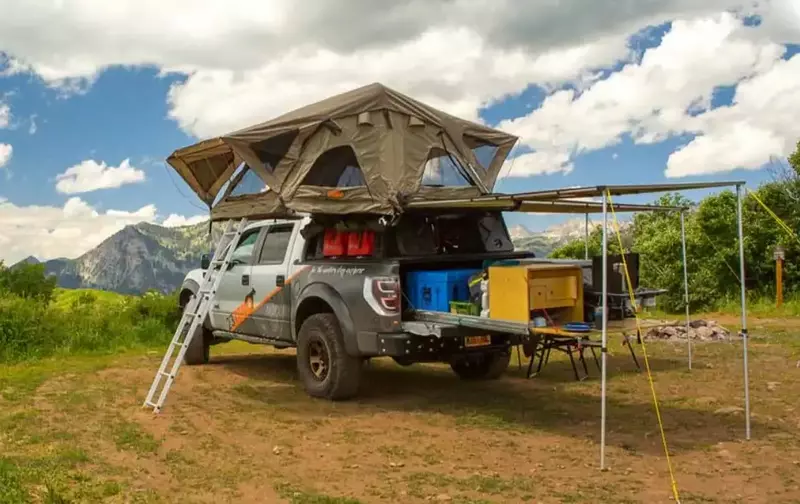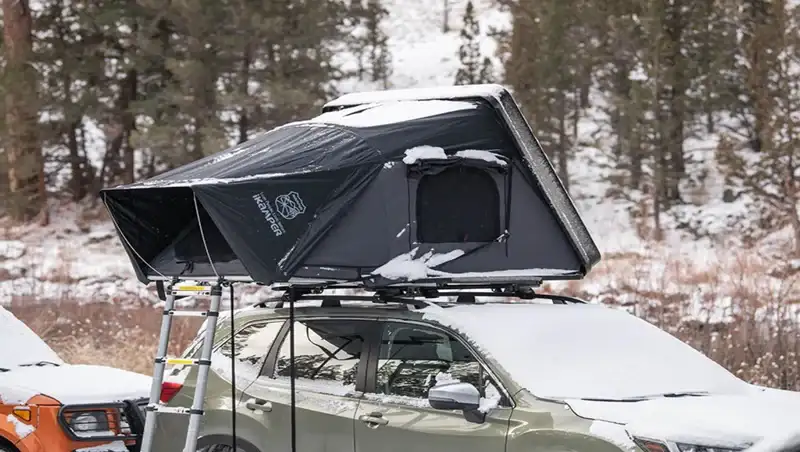Most of roof top tents may be even better for a cold but calm weather use than ordinary ground tents. This is based on their construction and the fact they are separated from the cold ground.
There are several features available in some of roof top tents that make them suitable for cold weather.
- Roof top tents are always with windows and doors that are fully closable.
- Some roof top tents are built from a polycotton fabric which naturally gives a bit more insulation than a synthetic fabric.
- There are also roof top tents that come with multiple layers in their walls.
- Some brands offer accessory inner insulation layers that can be added when necessary.
With at least some of these features combined, roof top tents are indeed suitable for any weather conditions and for year-round use.
Closable windows
Windows and great views are one of the best features of roof top tents. But when it rains and when you feel cold, you have to close all those openings.
This is never an issue, all of them have zippered panels for such situations. With this, you will prevent cold drafts and reduce losses of the warmth generated by your body.
Polycotton fabric helps
I do not remember seeing any roof top tent made of cotton, but there are many of them where polycotton is used. In this sense they are similar to polycotton ground camping tents. This fabric is a blend of two materials, polyester and cotton, and it combines great features of its two ingredients.
Polycotton is usually heavier and thicker than a synthetic fabric, and in many roof top tents built with this fabric, you also have an extra waterproof layer that adds weight. So such tents are normally also quieter in windy conditions.
This fabric alone does not help much of course, but combined with good windows zippers design it may add to your overall comfort.
This text is about cold, but a polycotton shelter is also a much better option for warm weather than any synthetic. This is useful too know because my guess is that more people will use such tents in the warmer part of a year.
Need some good examples of polycotton tents? Well, consider the Crua AER roof top tent, and also the Breezeway 72 Roof Top Tent by 23ZERO shown in the picture below.

Roof top tents with multiple layers
There is no doubt this is the property that helps much more than anything else. One excellent example of this type is the Freespirit Evolution rooftop tent presented in detail in my separate text.
So here you have walls that are built as a 3-layer quilted construction and this is what makes this roof top tent suitable for any weather and for year round use.
Note that such a multi-layer construction is rare in ground tents. You can find it only in a limited number of winter ground tents specifically designed for Arctic and Antarctic conditions.
Please see more about the mentioned Freespirit Evolution rooftop tent in this short video:
Accessory inner insulation
This is something really convenient to have. So you can order a relatively inexpensive inner layer that attaches easily from inside. This insulates the roof top tent and prevent heat losses.
This addition together with the multi-layer construction described above is the best you can have to have a bearable situation inside and to use the roof top tent year round.
There are several roof top tents brands that offer this, so follow the link to read more. But note also that there are insulated ground tents as well.
How about roof top tent type? Is a soft shell rooftop tent better than a hard shell rooftop tent for cold weather?
Quite generally, the answer is no. The reason is simple, in a pop up hard shell roof top tent you have both top and bottom built from a solid material.
This implies that there can be no heat loss through those areas that are in fact quite big. So possible heat loss sections are considerably reduced as compared with soft shell roof top tents where you have fabric everywhere except on the bottom.
Also, on the solid roof you normally have some insulation added. This is more against warmth, but this helps also in a cold environment.
The same holds also for the clamshell roof top tents. The top picture above shows one great example, the iKamper Skycamp 3.0 Mini roof top tent which is clearly in a winter environment.
So in a hard shell roof top tent you have only the sides that are made of fabric. But here too you can have some extra layers that protect you from the cold. The previously mentioned Freespirit Evolution rooftop tent is a perfect example of that type.
If cold weather involves also possible snow, you can be sure that a rigid roof should be better in such situations.
Final thoughts
In summary, it can be said that quite generally roof top tents are not bad at all for cold weather camping. In my view, they are better than ordinary ground camping tent.
In a roof top tent, you are far from the cold ground, and you have an insulated floor, and sometimes even the roof is insulated. This is something to consider when you compare them with instant setup ground tents.
Let me know what you think, there is a comment box below. Thank you for reading and have a nice day.

 Hi, I am Jovo, the founder of this Off-Ground Tents site and several other outdoor sites. I have been mountaineering for almost 40 years already, and I have created this site to use as a reference for various types of above ground tents.
Hi, I am Jovo, the founder of this Off-Ground Tents site and several other outdoor sites. I have been mountaineering for almost 40 years already, and I have created this site to use as a reference for various types of above ground tents.